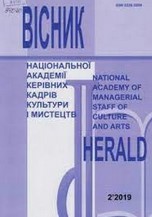ВІЗУАЛЬНА КОМУНІКАЦІЯ ЯК ФЕНОМЕН МАСОВОЇ КУЛЬТУРИ
VISUAL COMMUNICATION AS A MASS CULTURE PHENOMENON
Author(s): Denysyuk ZhannaSubject(s): Media studies, Sociology of Culture, ICT Information and Communications Technologies
Published by: Національна академія керівних кадрів культури і мистецтв
Keywords: mass culture; visual communication; image semantics; digital environment; communication; cultural practices;
Summary/Abstract: The purpose of the work is to investigate the phenomenon of visual communication, which is largely mediated by the emergence and development of mass culture, and in the conditions of the digital information, environment acquires the features of a universal cultural code. The research methodology is based on applying a systemic approach, an analytical method, cultural, semiotic, and axiological, which will allow a comprehensive consideration of the given problem and formulate well-founded conclusions. The scientific novelty is characterized by the fact that for the first time the problems of visual communication were investigated in terms of mass culture, which, thanks to the same visuality, is transformed in the conditions of the emergence and development of information digital technologies, which have become a system-forming factor for the cultural phenomena of the digital environment, which acquires the features of a complete socio-cultural space capable of producing values and meanings, to organize everyday society, thereby fulfilling the function of mass culture. Conclusions. Visual communication mediated by the digital environment and technologies is not only a full-fledged component of cultural practices, and processes of information exchange, but also a producer of meanings, values, and values embedded in the architecture of visual images. Today, the Internet environment is not only a modern powerful channel of communication but also a complete socio-cultural space that produces new cultural practices, saturating them with new meanings and meanings. Visual content formed on the Internet, thanks to the application of the game principle as a communicative strategy, and being saturated every time with other creative ideas for the reproduction of socially significant information for the participants of the communicative process, becomes a separate segment of cultural reality that produces new meanings and meanings. Visuality as a sign of a mass culture in the space of communication acquires new meanings, forming the universality of visual language, which, however, can be filled with values and meanings of a specific culture. Modern socio-cultural practices, mediated by the Internet network, have most contributed to the formation of separate Internet culture, and especially to the formation of its new digital forms, which are the result of both individual and collective creativity. This marked a new era in the development of the Internet in general, as well as in the development of the principles of communication, which was primarily caused by the emergence of social networks, blogs, which provided an opportunity to express one's own opinion, creativity, and their distribution among the familiar and unfamiliar public. Accordingly, in the development of modern socio-cultural practices, we observe a direct dependence on informational and technological progress.
Journal: Вісник Національної академії керівних кадрів культури і мистецтв
- Issue Year: 2022
- Issue No: 2
- Page Range: 9-14
- Page Count: 6
- Language: Ukrainian

